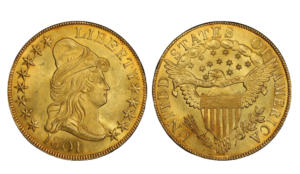The Intriguing Story of the 1801 $10 Draped Bust Gold Eagle
Posted onAs America hurtles toward a significant presidential election in just a few months, Thomas Jefferson’s inaugural address in 1801 carries an instructive theme.
Students of American history will remember that in 1801, Thomas Jefferson was sworn in as the third president of the United States.
His victory over incumbent president John Adams marked the first time the American presidency changed from one party to another—shifting from the Federalist party to the Republican party.
After a bitter and hard fought election season, Jefferson sought to unite the nation during his inaugural speech. He famously said: “We are all Republicans, we are all Federalists” and he called on Americans “unite in common efforts for the common good.”
In that year, one of the most beautiful and popular gold coins was minted in Philadelphia: The 1801 $10 Draped Bust Gold Eagle. Ten dollar gold eagles of this time are one of the most sought after early American gold coins. Collectors are attracted to the beauty of these significant gold coins from a historic era when our young nation was coming into its own.
The $10 Gold Eagle was the highest denomination coin authorized in the Mint Act of 1792. The $10 Gold Eagle represented a great deal of money at that time. Because of its high street value, the Gold Eagles of this era proved to have little demand in domestic circulation.
The Philadelphia Mint struck only 44,344 $10 Draped Bust Gold Eagles in 1801. Most of these gold eagles were shipped overseas and ultimately melted down for their bullion value. That led to a survival estimate today of only 750 known specimens in all grades. These coins are rare.
Robert Scot, Chief Engraver at the U.S. Mint, designed the memorable coin. The key themes of Scot’s work included ideals like unity, liberty, and rebellion, which were at the core of the American Revolution—and they are represented in this coin as well.
Today, the Draped Bust represents Scot’s biggest legacy in the numismatic world and his most famous and sought after design: the Draped Bust depiction of Liberty.
The reverse of the 1801 $10 Gold Eagle is known as the Heraldic Eagle type, and features Scot’s famous rendering of the Great Seal of the United States: the Eagle and the Shield. The Great Seal, of course, represents America’s strength, unity, and independence and remains a powerful symbol today.
Want to read more? Subscribe to the Blanchard Newsletter and get our tales from the vault, our favorite stories from around the world and the latest tangible assets news delivered to your inbox weekly







